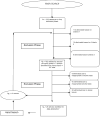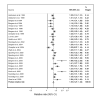The more you drink, the harder you fall: a systematic review and meta-analysis of how acute alcohol consumption and injury or collision risk increase together
- PMID: 20236774
- PMCID: PMC2887748
- DOI: 10.1016/j.drugalcdep.2010.02.011
The more you drink, the harder you fall: a systematic review and meta-analysis of how acute alcohol consumption and injury or collision risk increase together
Abstract
Alcohol consumption causes injury in a dose-response manner. The most common mode of sustaining an alcohol-attributable injury is from a single occasion of acute alcohol consumption, but much of the injury literature employs usual consumption habits to assess risk instead. An analysis of the acute dose-response relationship between alcohol and injury is warranted to generate single occasion- and dose-specific relative risks. A systematic literature review and meta-analysis was conducted to fill this gap. Linear and best-fit first-order model were used to model the data. Usual tests of heterogeneity and publication bias were run. Separate meta-analyses were run for motor vehicle and non-motor vehicle injuries, as well as case-control and case-crossover studies. The risk of injury increases non-linearly with increasing alcohol consumption. For motor vehicle accidents, the odds ratio increases by 1.24 (95% CI: 1.18-1.31) per 10-g in pure alcohol increase to 52.0 (95% CI: 34.50-78.28) at 120 g. For non-motor vehicle injury, the OR increases by 1.30 (95% CI: 1.26-1.34) to an OR of 24.2 at 140 g (95% CI: 16.2-36.2). Case-crossover studies of non-MVA injury result in overall higher risks than case-control studies and the per-drink increase in odds of injury was highest for intentional injury, at 1.38 (95% CI: 1.22-1.55). Efforts to reduce drinking both on an individual level and a population level are important. No level of consumption is safe when driving and less than 2 drinks per occasion should be encouraged to reduce the risk of injury.
Copyright 2010 Elsevier Ireland Ltd. All rights reserved.
Figures





References
-
- Anda RF, Williamson DF, Remington PL. Alcohol and fatal injuries among US adults. Findings from the NHANES I Epidemiologic Follow-up Study. JAMA. 1988;260:2529–2532. - PubMed
-
- Babor T, Caetano R, Casswell S, Edwards G, Giesbrecht N, Graham K, Grube J, Gruenewald P, Hill L, Holder H, Homel R, Österberg E, Rehm J, Room R, Rossow I. Alcohol: No ordinary commodity. Research and public policy. Oxford University Press; Oxford and London: 2003.
-
- Bazargan-Hejazi S, Gaines T, Duan N, Cherpitel C. Correlates of injury among ED visits: effects of alcohol, risk perception, impulsivity, and sensation-seeking behaviours. Am J Drug Alcohol Abuse. 2007;33:101–108. - PubMed
-
- Begg CB, Mazumdar M. Operating characteristics of a rank correlation test for publication bias. Biometrics. 1994;50:1088–1101. - PubMed
-
- Borges G, Cherpitel C, Macdonald S, Giesbrecht NA, Stockwell T, Wilcox HC. A case-crossover study of acute alcohol use and suicide attempt. J Stud Alcohol. 2004;65:708–714. - PubMed
Publication types
MeSH terms
Grants and funding
LinkOut - more resources
Full Text Sources
Medical
Miscellaneous

